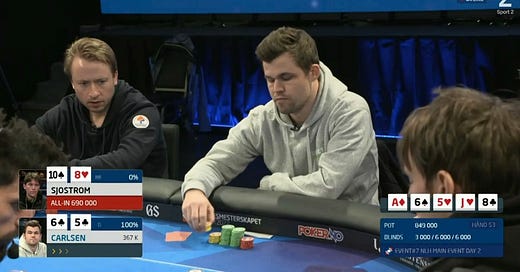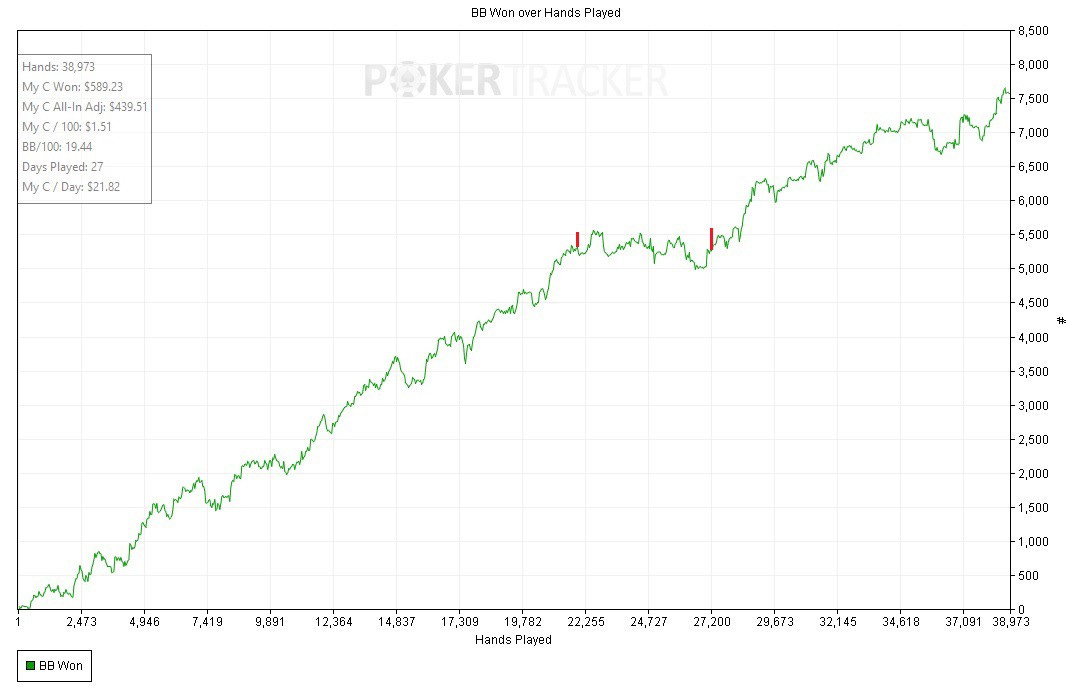This week Magnus Carlsen took a break from chess to compete in the Norwegian Poker Championship. It seems he knows a thing or two about poker: As of this writing he’s one of the chip leaders.
I made a living playing poker for seven years. During that time I didn’t play much chess. When you spend many hours per day playing a game for money, it’s less appealing to play a different game as a hobby. But when I quit poker and started to get back into chess, I found my perspective had changed.
There are some big differences between chess and poker. In poker there is hidden information - your opponents’ cards - and the random element of cards dealt from a deck. Ultimately though both are games of strategy. Mastering chess and poker requires finding effective ways to study, think, and finally to master yourself.
Maximize your expected value
The most obvious difference between chess and poker is that poker has more luck. In poker you can be all-in and have no more decisions to make, but the remaining cards can still change the outcome of the hand. This means that the result of any given hand is not a reliable indicator on how well you played. You could have played well and got unlucky, or played poorly and got lucky.
For that reason poker players need to take a longer view. If the same hand played out many times, what would be the average result? This is called expected value, or EV. The goal of poker is to maximize your EV.
From a math perspective, EV equals the size of the pot times your chance of winning. For example, say there’s $1000 in the pot and you have a 70% chance of winning. Your EV is
$1000 * 70% = $700
But you’ll never receive $700 in any single hand. You’ll either win and get $1000, or lose and get $0. The key point is it doesn’t really matter whether you win or lose this time. In the long run the lucky and unlucky hands will more or less balance out, so you need to focus on getting in more profitable situations: increasing your EV. This comes down to decision making and strategy.
It might not seem obvious how this applies to chess, because for one thing there’s no money, but the math is actually quite similar. In chess, as with poker, EV is determined by the value of an event times the probability of it happening. For chess that looks like this:
1 * Win + 0.5 * Draw + 0 * Loss
which simplifies to
Win + 0.5 * Draw
Before my poker career, like most chess players, I was focused on playing the “best” move - the one the computer would recommend. But poker taught me to think in terms of maximizing my EV. To make this shift more concrete, let’s look at an example. In this rapid training game my opponent had just played the retreat Nf6-d7. I had an advantage on the clock of around five minutes to one minute.
Nxf7 looks promising, but it’s difficult to calculate the lines to a forced win. After Nxf7 Kxf7 Rxe6 Kxe6 the follow-up isn’t obvious, to me anyway. Meanwhile, the simple retreat Nf3 leaves me with all the positional trumps and no counterplay. Estimating the probabilities would look something like:
Nxf7: 70% win, 10% draw, 20% loss
EV = 70% + 0.5 * 10% = 75%
Nf3: 75% win, 20% draw, 5% loss
EV = 75% + 0.5 * 20% = 85%
Nxf7 might let me win the game with a direct attack, but there’s also a decent chance of losing if my attack fizzles out. In contrast, with Nf3 there’s a good chance I will manage to win using my positional advantage and clock advantage. The only way I can lose this game is by making a big unforced error, which is possible but unlikely. So overall it seems like Nf3 is a better way to maximize my expected value in this situation.
You might disagree with the numbers based on your own evaluation of the position, or your strengths and weaknesses as a player, and that’s totally fine. Actually it’s part of the point. It’s not really about the numbers, it’s about a mindset shift from “the best move” to “the move that maximizes my chances for a good result” taking into account the position, the clock, and the propensity of both players to make mistakes in the future.
Focus on the big picture
Poker players tend to spend a lot of time looking at “the graph.” On the graph, the x-axis is time and the y-axis is winnings. Naturally, since poker has a large luck element, the graph tends to be pretty jagged. There are big wins and big losses. But if you’re a winning player, if you zoom out far enough, that jaggedness should give way to an overall upward trend.
Chess doesn’t have an obvious random element like cards dealt from a deck, but if you look at the graph of your rating over time, it looks suspiciously like a poker graph: jagged, with lots of ups and downs.
How to account for this jaggedness, given that there is (seemingly) no random element in chess? My answer would be that the cards are far from the only random element in poker, only the most obvious. There is also…
Who else happens to be sitting at your table
How your opponents play
How you play (!)
How your hands line up with your opponent’s hands
How somewhat random decisions by you and your opponents interact
…and many others. These elements may not be exactly what you think of as luck, but they are certainly not 100% under your control. And if you say that you do control how you play, may I ask why you don’t simply choose to make good moves all of the time?
These factors are just as much a part of the uncertainty of poker as the obvious luck of the cards that come off the top of the deck. And most of these factors are just as present in chess as they are in poker. You don’t control how your opponent plays. You don’t control how your imperfect reasoning interacts with your opponent’s imperfect reasoning.
What you can do is to focus on process over outcome. Look at that rating graph and imagine zooming in on a single dip. Think about how you would react in that moment. Now imagine two players:
Player A reacts to every dip by freaking out, changing their openings, changing their study plan, or quitting chess for a month. Player B takes losses in stride, learns what they can from them, and carries on with a sensible training plan.
Who is more likely to succeed in the long run? It’s all too obvious that it’s Player B. But many chess players are still living the Player A life.
Look for patterns
In poker, we call a systematic hole in your game a “leak,” as in a hole in a boat. The point is that water does not enter through a leak just once, it enters continuously and predictably. Therefore plugging leaks is crucial to succeeding in the long run.
When you analyze your chess games, you’re reviewing mistakes you made in the past, but those aren’t actually the mistakes you care about. The mistakes you care about are the ones you’ll make in the future - and how you can avoid them. This means that simply recognizing a move was a mistake and identifying the best move is not, in itself, very helpful. You need to connect it to some sort of process that will allow you to make better moves in the future.
Two ways to transform mistakes into processes you can use going forward:
Categorize mistakes and look for categories that come up frequently. For example, at one point I noticed I was losing games because I was going pawn-grabbing too often in the opening. In each specific situation, I always thought I could get away with taking the pawn, but more often than not I was punished for neglecting my development before I could use the extra pawn. In the big picture, it was obvious that I was systematically underrating the risks of neglecting development to capture a pawn.
Don’t just note the best move, work out the thought process that would have allowed you to find the best move. For example, “The winning line started with an obvious capture that I simply didn’t consider. Had I started down the line, I would have easily seen the win. In the future I need to make sure to consider forcing moves like checks and captures.” If there is no plausible thought process that would have allowed you to find the move, then that move is not relevant for you, even if the computer says it’s best.
Zoom out
The biggest thing I learned from poker is to zoom out and see the big picture. If you focus on results in the short term, most of what you see will be noise - random variation. In poker this is easy to understand as the luck of the cards. In chess the source of the variation is more mysterious, but I’ve come to believe that many short term changes in chess performance are random, or may as well be, because you can never identify them. All you can do is stick with strategies that make sense and work in the long run. And it helps to have a sense of humor about losses because one thing for sure in chess and poker is that you will encounter a lot of them.









Some of this stuff could be relevant to stock picking as well.
Chess is a humbling game where the goal for me it to simply have my wins + draws > 51%...then the trend goes up and to the right. When you fall off the horse, get back on. Great article as always.